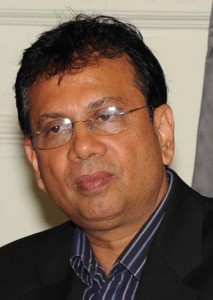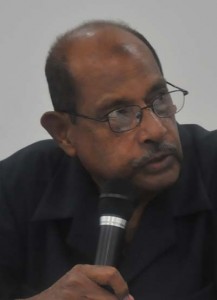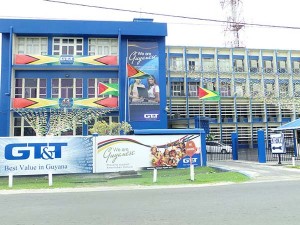Latest update November 24th, 2024 1:00 AM
Latest News
- Windfall taxes do not violate petroleum contract – T&T Energy Expert
- All oil projects in Guyana performing above expectation in the world’s premier deepwater zone- Exxon CEO tells shareholders
- More than 100 Palestinians killed in Israeli attacks on Gaza in 48 hours
- GECOM to continue discussions on introducing biometrics before engaging stakeholders
- Corentyne fire that killed mother and four children maliciously set – GFS
Regulator, GT&T at odds with rate hikes rejection
Apr 12, 2015 News
An application by the Guyana Telephone and Telegraph Company (GT&T) to hike rates for a number of
services has resulted in regulators now contemplating an investigation to determine the true value of the assets of the Telephone company.
GT&T had applied to the Public Utilities Commission (PUC) for an increase in rates for some services it provides; a net reduction in outbound rates and the setting of a tariff for certain services for which there had been none.
In its ruling last month, PUC said that it had difficulty in arriving at a decision favourable to GT&T and as such dismissed it.
“The Commission wishes to inform that in view of doubts relating to the true value of GT&T’s asset base it may consider having an investigation carried out in this regard,” PUC’s Chairman,
Justice Prem Persaud and Commissioners Badrie Persaud and Maurice Solomon said in the ruling.
On Friday, GT&T’s Chief Executive Officer, Radhakrishna Sharma, said that the PUC order is an outright rejection of its effort to adjust rates – including lowering long distance rates and introducing new and enhanced services for customers – to reflect changes in the market since the last comprehensive rate review over a decade ago.
“It’s an unfortunate outcome for consumers, who would have received lower rates and enhanced services, and it’s a lost opportunity to remove a roadblock in the path towards liberalization.”
The executive said that GT&T has filed an appeal and will continue to work for changes that allow
for the adjusting of rates to reflect today’s market realities and provide more services to consumers.
The reason for the application, according to PUC, was that GT&T wanted to give effect to a minimum of 15 per cent return on capital dedicated to public use.
The 15 per cent return is provided for under the terms of the licence which provides that GT&T shall be entitled to a minimum rate of return of 15% on capital dedicated to public use.
Making contributions to the public hearings on the application were Guyana Consumers’ Association (GCA), Leonard Craig- a consumer advocate and Valmikki Singh, Chief Executive Officer of the National Frequency Management Unit (NFMU).
According to PUC, GT&T claimed that it suffered a deficit of $738 million and it will need that extra amount to maintain its 15 per cent.
PUC said that it was “invariably” told by GT&T that the finances were commingled and separate accounts were not available.
The regulator said that its job was not complex- it had to determine whether the company was getting a minimum of 15% which must be calculated on the plant, machinery, among other assets of the company.
Questionable Figures
PUC said that GT&T did not submit separate financial statements. “All the
revenues and expenses are merged so we do not get a true picture what it costs, say, for the regulated sector to function. We do not have an idea what machinery and plant, and what percentage of them is used for the non- regulated sectors.”
PUC said that the Telephone company claimed that in October 2014, it was making a 10 per cent rate of return. “We do not know how much of that is from each sector. The GT&T tells us that anything earned in excess of 15% is permissible—even if they earn 40-50 per cent.”
PUC said that the agreement in which GT&T relies to extract their minimum 15 per cent, dated June 18, 1990 provides that GTT establish facilities permitting telephone service along the entire coast from Crabwood Creek to Suddie and in the interior at several locations within three years.
“Many persons are not the recipients of the telephone service. GT&T explains that it is awaiting the grant or release of spectrum to provide the service. GT&T has been in operation, by way of monopoly, for the past 24 years and yet cannot fulfill that obligation which it undertook when the agreement was signed.”
The regulator pointed out that there was no condition for the provision of spectrum—and being a monopoly for the land line service they choose to ignore the requests of potential consumers, blaming it on “spectrum”.
8,000 Landline Applications
Craig, the consumer advocate, argued that, among other things GT&T’s landline software had space for expansion but the company has 8000 applications that it is not fulfilling.
PUC said that it was pointed out that GT&T could have earned more if it activated those landlines. “GT&T, however, responded that activation of all inactive models would generate only an insignificant income. Even so, such activation would enhance services to consumers.”
PUC said it was of the opinion that GT&T was proceeding with its application on the basis that it has a “guarantee”, come hell or high water, to collect its “no less than 15%”.
PUC was critical of the fact that thousands of citizens who request and require the land line service do not get it yet millions of US dollars are expended by the company without a business plan in place.
“We are not certain of the financial implication if all the unserved consumers were supplied with the service: We urge that the company take steps to fulfill the expectation of all potential consumers in the shortest possible time.”
The regulator expressed concern over the US$30M fibre optic cable brought from Suriname a few years ago by the telephone company. PUC said that GT&T was unable to provide details.
PUC expressed alarm that the cable is not part of GT&T’s assets. It was transferred to a wholly-owned subsidiary company, in the British Virgin Islands.
“This is really an investment by GT&T. The business of the subsidiary is to sell bandwidth to service providers, and GT&T has been that company’s only purchaser of bandwidth in 2011. Bandwidth is an essential component in the lucrative internet business and in which GT&T is prominently involved. We are not aware that GT&T has been earning any interest on the funds expended in the creation and functioning of the subsidiary,” PUC said.
PUC said that it does not have the practicability to regulate transactions with affiliates which may involve the examination of their books and records.
“This can be very critical in tracing the bona fides of an affiliated transaction. The subsidiary does not come under our jurisdiction/purview thus making it impossible to review/examine its books, account papers or records kept by them.”
PUC said that in monitoring the operations of utility companies under its purview, it has long held the view that GT&T appears to inflate the cost of its capital acquisitions.
“This will increase the asset base of the Company resulting in higher profits to which it is not entitled. If this is so then the depreciation figures stated in the financial statement would be overstated. We are also concerned about the valuation of the Company’s assets and its reluctance to respond to our requests for the acquisition costs of assets for specific periods.
“We also have a difficulty reconciling the company’s test year data and investigations must be conducted seeking explanations on the computation of property, plant and equipment, and working capital.”
GT&T Blocked
Sharma on Friday said that his company will keep on pushing despite the fact that the telecoms industry lags well behind most nations in this hemisphere.
“GT&T has consistently faced regulatory roadblocks as we’ve tried to modernize our networks and introduce 3G and other new services. Even still, we’ve invested US$250M since our last rate change – 15 years ago – and more than USD$391M since our contract started. Let me be clear — we stand ready to work with the government to finally develop a clear and consistent plan for moving the telecoms sector forward.”
He said that GT&T would normally be happy to address the specific points the PUC made – but in this case, the order is really just a list of grievances that are without merit in a modern Telecommunications sector.
“It is not based on a logical adherence to the law, a reasonable consideration of the voluminous record, or consistent with past PUC decisions and rulings. Given that the PUC order fails on fundamental points of law, ignores PUC precedent and rejects changes that are clearly in the consumer interest, we’re very confident our appeal will be successful.”
He said that the decision by the PUC clearly reflects the fact that the country has a less than clear vision for the future of telecommunications. “Unless changes are made, Guyana’s Telecommunication sector is going to fall further and further behind.”
He said that Guyana is one of very few countries in the western hemisphere that is yet to deploy a 3G network. “GT&T repeatedly has requested spectrum necessary to provide 3G and we believe our competitor has done the same. The government could facilitate the deployment of 3G at any time by releasing spectrum to the legally licensed carriers.”
Share this:
- Click to print (Opens in new window)
- Click to email a link to a friend (Opens in new window)
- Click to share on Facebook (Opens in new window)
- Click to share on WhatsApp (Opens in new window)
- Click to share on Twitter (Opens in new window)
- Click to share on Pinterest (Opens in new window)
- Click to share on Pocket (Opens in new window)
- Click to share on Tumblr (Opens in new window)
- Click to share on Reddit (Opens in new window)
- Click to share on LinkedIn (Opens in new window)
Related
Similar Articles

The Glenn Lall Show | November, 20th, 2024
Follow on Tik Tok @Glennlall
THE BLUNT OF THE DAY

Sports
Nov 24, 2024
ESPNcricinfo – A maiden Test century for Justin Greaves headlined a dominant day for West Indies against Bangladesh on day two of the Antigua Test. After his 115 helped West Indies post 450 for...Features/Columnists
Jagdeo’s idea of transparency
…Peeping Tom kaieteur News- Transparency, as conceived by Vice President Bharrat Jagdeo, seems to be a peculiar exercise... more
Rising Gun Crimes in the Caribbean: Urgent Action required by all
By Sir Ronald Sanders Kaieteur News – There is an alarming surge in gun-related violence, particularly among younger... more
Publisher’s Note
Freedom of speech is our core value at Kaieteur News. If the letter/e-mail you sent was not published, and you believe that its contents were not libellous, let us know, please contact us by phone or email.
Feel free to send us your comments and/or criticisms.
Contact: 624-6456; 225-8452; 225-8458; 225-8463; 225-8465; 225-8473 or 225-8491.
Or by Email: [email protected] / [email protected]
Weekend Cartoon

















